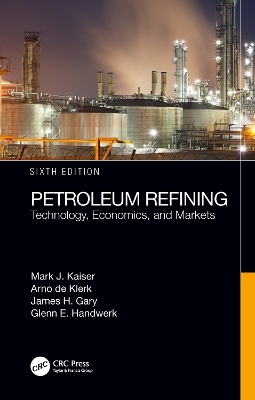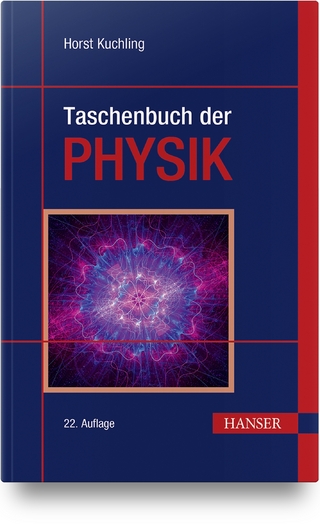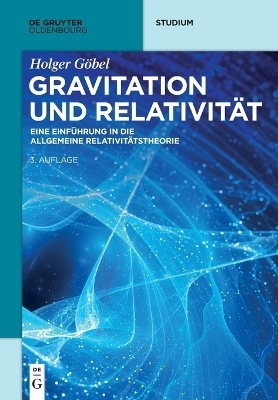
Petroleum Refining
Crc Press Inc (Verlag)
978-1-4665-6300-1 (ISBN)
For four decades, Petroleum Refining has guided thousands of readers toward a reliable understanding of the field, and through the years has become the standard text in many schools and universities around the world offering petroleum refining classes, for self-study, training, and as a reference for industry professionals.
The sixth edition of this perennial bestseller continues in the tradition set by Jim Gary as the most modern and authoritative guide in the field. Updated and expanded to reflect new technologies, methods, and topics, the book includes new discussion on the business and economics of refining, cost estimation and complexity, crude origins and properties, fuel specifications, and updates on technology, process units, and catalysts.
The first half of the book is written for a general audience to introduce the primary economic and market characteristics of the industry and to describe the inputs and outputs of refining. Most of this material is new to this edition and can be read independently or in parallel with the rest of the text. In the second half of the book, a technical review of the main process units of a refinery is provided, beginning with distillation and covering each of the primary conversion and treatment processes. Much of this material was reorganized, updated, and rewritten with greater emphasis on reaction chemistry and the role of catalysis in applications.
Petroleum Refining: Technology, Economics, and Markets is a book written for users, the practitioners of refining, and all those who want to learn more about the field.
Mark J. Kaiser, Arno de Klerk, James H. Gary, Glenn E. Handwerk
Part 1. Markets and Economics
Section 1: Industry Structure and Characteristics
1. Performance
1.1 Refinery Supply Chains
1.1.1 Input-Output Model
1.1.2 Infrastructure
1.1.3 Location
1.1.4 Commercial Requirements
1.2 Performance
1.3 Refinery Economics
1.4 Refining Yields
1.5 Refining Margins
1.5.1 Gross Margin
1.5.2 Net Margin and Netback
1.5.3 Application
1.6 Margin Comparisons
1.6.1 Sweet vs. Sour Crude
1.6.2 Cracker vs. Coker Refinery
1.7 Factors That Impact Margins
1.8 Crack Spreads
1.9 Market Data
References
2. Products
2.1 Overview
2.2 Petroleum Gases
2.2.1 Methane
2.2.2 Ethane
2.2.3 Propane
2.2.4 Butane
2.2.5 Natural Gas Liquids
2.3 Light Distillates
2.3.1 Naphthas
2.3.2 Gasolines
2.4 Middle Distillates
2.4.1 Jet Fuel
2.4.2 Kerosene
2.4.3 Automotive Diesel
2.4.4 Marine Diesel
2.4.5 Light Fuel Oil
2.5 Heavy Fuel Oils
2.6 Specialty Products
2.6.1 Base Oils and Lubricants
2.6.2 Engine Oils
2.6.3 Greases
2.6.4 Waxes
2.6.5 Bitumen
2.6.6 Petroleum Coke
2.6.7 Carbon Black
References
3. Processes
3.1 Overview
3.2 Separation
3.2.1 Perfect Batch Distillation
3.2.2 Distillation Curves
3.2.3 Fractions
3.2.4 Atmospheric Distillation
3.2.5 Vacuum Distillation
3.3 Conversion
3.3.1 Thermal Cracking
3.3.2 Catalytic Cracking
3.3.3 Hydrocracking
3.3.4 Coking
3.4 Finishing
3.4.1 Hydrotreating
3.4.2 Catalytic Reforming
3.4.3 Alkylation
3.4.4 Isomerization
References
4. Prices
4.1 Introduction
4.2 Price Formation
4.3 Global Oil and Product Markets
4.4 Price Characteristics
4.4.1 Prices are Volatile
4.4.2 Prices are Unpredictable
4.4.3 Business Cycle Impacts are Periodic
4.4.4 Price Shocks
4.4.5 Market Factors Dominate Price Signals
4.4.6 Private Factors are Secondary in Price Formation
4.5 Supply and Demand
4.5.1 Supply Curves
4.5.2 Demand Curves
4.5.3 Equilibrium
4.6 Market Factors
4.6.1 Demand
4.6.2 Supply
4.6.3 Production Cost
4.6.4 OPEC
4.6.5 Spare Production Capacity
4.6.6 Supply Disruptions
4.6.7 Technology Impacts
4.7 Private Factors
4.7.1 Quality
4.7.2 Yield
4.8 World Production circa 2017
4.9 Refined Product Prices
References
5. Potpourri
5.1 Business Model
5.1.1 Required Spending
5.1.2 Discretionary Spending
5.1.3 Capital Investments
5.2 Company Classification
5.2.1 Firm Type
5.2.2 Ownership
5.2.3 Level of Integration
5.2.4 Business Objectives
5.3. U.S. and World Capacity Trends
5.3.1 Distillation
5.3.2 Coking
5.3.3 Catalytic Cracking
5.3.4 Hydrocracking
5.3.5 Hydrotreating
5.3.6 Reforming, Alkylation, Isomerization
5.3.7 Aromatics and Lubricants
5.3.8 Hydrogen
5.3.9 Sulfur
5.3.10 Asphalt
5.4. U.S. Capacity Correlations
5.5 Market Valuation
5.6 Capital Investment
References
Section 2: Cost Estimation and Complexity
6. Cost Estimation
6.1 Construction Cost Factors
6.1.1 ISBL
6.1.2 USGC Reference
6.1.3 Project Type
6.1.4 Unit Addition vs. Grassroots Refinery
6.1.5 Process Technology
6.1.6 Process Severity
6.1.7 Unit Requirements
6.1.8 Contract Type
6.1.9 Actual vs. Estimated Cost
6.1.10 Time
6.1.11 Location
6.2 Unit Cost
6.2.1 Source Data
6.2.2 Sample Size
6.2.3 Normalization
6.3 Cost Functions
6.3.1 Specification
6.3.2 Dependent Variable
6.3.3 Parameter Estimation
6.3.4 Data Processing
6.3.5 Data Exclusion
6.3.6 Cost Envelopes
6.4 USGC Grassroots Construction Cost
6.5 Operating Cost Factors
6.5.1 Common vs. Unique Factors
6.5.2 Utility Prices
6.5.3 Capacity, Complexity, Age
6.5.4 Time
6.5.5 Location
6.5.6 Exceptional Events
6.6 Operating Expenses
6.6.1 Data Sources
6.6.2 Consolidation Levels
6.7 U.S. Operating Cost Statistics, 2010-2014
References
7. Refinery Complexity
7.1 Ideal Refinery
7.2 Nelson Complexity Index
7.2.1 Motivation
7.2.2 Complexity Factor
7.2.3 Refinery Complexity
7.3 Complexity Factors
7.3.1 Definition
7.3.2 Measurement
7.3.3 Complexity Cross Factor
7.3.4 Uncertainty
7.3.5 Traditional Approach
7.4 Refinery Complexity
7.5 U.S. and World Statistics circa 2018
7.5.1 Regional Capacity
7.5.2 U.S. Refining Complexity
7.5.3 Largest World Refineries
7.5.4 Conversion Capacity
7.5.5 FCC-Equivalent Capacity
7.6 Complexity Equation
7.7 Cost Estimation
7.8 Complexity Factor at Reference Capacity
7.8.1 Specification
7.8.2 U.S. CFRC Statistics
References
8. Classification
8.1 Refinery Categories
8.2 Very Simple Refinery
8.3 Simple Refinery
8.4 Complex Refinery
8.5 Krotz Springs, Louisiana
8.6 St. Paul Park, Minnesota
9. Complexity Applications
9.1 Introduction
9.2 Complexity Functional
9.2.1 Reference Capacity Approach Extension
9.2.2 Factor Functional Average
9.2.3 Evaluation
9.2.4 Closed-Form Expressions
9.2.5 Comparison
9.2.6 U.S. Refinery Complexity
9.3 Complexity Moments
9.4 Spatial Complexity
9.5 Replacement Cost
9.6 Sales Price Models
9.6.1 Asset Transactions
9.6.2 Formulation
9.6.3 Constraints
9.7 Complexity Barrels
9.8 Inverse Problem
9.8.1 Three Refinery Example
9.8.2 Matrix Formulation
References
10. Modern Refineries
10.1 Hydrocracker
10.2 Lubes
10.3 Integrated/Petrochemical
Section 3: Crude Oil and Properties
11. Origin and Composition
11.1 Geologic Time
11.2 Generation, Migration and Accumulation
11.2.1 Source Rock
11.2.2 Generation
11.2.3 Migration
11.2.4 Accumulation
11.2.5 Sedimentary Basins
11.3 The Hydrocarbon Source
11.3.1 Origin
11.3.2 Kerogen Type
11.3.3 Oil Window
11.3.4 Transformation Sequence
11.4 Molecular Composition
11.4.1 Naming Organic Chemicals
11.4.2 Early Classifications
11.4.3 Hydrocarbons
11.4.4 Paraffin (Alkane) Series
11.4.5 Naphthene (Cycloparaffin) Series
11.4.6 Aromatic (Benzene) Series
11.5 Crude Oil Classification
11.5.1 Component Groups
11.5.2 Ternary Diagram
11.5.3 Tissot-Welte Classification
11.5.4 Crude Oil Classes
11.5.6 Marine vs. Nonmarine Organic Matter
11.5.7 High Sulfur vs. Low Sulfur Oils
11.6 Alteration and Thermal Maturity Pathways
11.6.1 Thermal Alteration
11.6.2 Deasphalting
11.6.3 Biodegradation
11.6.4 Water Washing
Reference
12. Crude Quality
12.1 Indicators
12.1.1 Color
12.1.2 Density
12.1.3 Heteroatoms
12.1.4 Chemical Structure
12.1.5 Viscosity
12.2 Classification
12.3 Blends of Crude Oils
12.3.1 Additive Properties
12.3.2 Nonadditive Properties
References
13. Distillation Profile
13.1 Distillation Curves
13.2 Laboratory Methods
13.2.1 Standards
13.2.2 ASTM D86
13.2.3 ASTM D1160
13.2.4 ASTM D2892
13.2.5 ASTM D2887
13.2.6 ASTM D6352, D7169
13.3 Hempel Method
13.3.1 Procedure
13.3.2 40 mmHg Pressure Correction
13.3.3 Temperatures Beyond 790°F
13.3.4 Gravity Midpercent
13.3.5 Heavy Hydrocarbons
13.4 Distillation Profile Summary
13.5 Hasting Field, Texas
13.6 North Slope Crude, Alaska
References
14. Crude Properties
14.1 Bayon Choctaw and West Hackberry Blends
14.2 Crude Oil Assay
14.3 Chemical Properties
14.3.1 Elemental Analysis
14.2.2 PNA Composition
14.3.3 Carbon Residue
14.4 Composition
14.4.1 Carbon Hydrogen Ratio
14.4.2 Sulfur
14.4.3 Nitrogen
14.4.4 Metals
14.4.5 Asphaltenes
14.4.6 Resins
14.4.7 Waxes
14.4.8 Salt Content
14.4.9 Acid Number
14.5 Physical Properties
14.5.1 Molecular Weight
14.5.2 API Gravity
14.5.3 UOP Characterization Factor
14.5.4 Viscosity
14.5.5 Pour Point
14.5.6 Reid Vapor Pressure
References
15. Fraction Characterization
15.1 Correlation Relations
15.2 Carbon Hydrogen Weight Ratio
15.3 Carbon Residue
15.4 Asphaltene Content
15.5 Molecular Weight
15.6 Aniline Point
15.7 Smoke Point
15.8 Viscosity
15.9 Refractive Index
15.10 Cloud Point
15.11 Pour Point
15.12 Freezing Point
15.13 Cetane Index
15.14 Molecular Type Composition
References
Section 4: Fuel Specifications
16. Standards, Specifications and Fuel Quality
16.1 Types of Specifications
16.2 Consensus Specifications Definitions
16.3 Test Methods
16.4 Transportation Fuel Specifications
16.4.1 Gasoline – ASTM D4814
16.4.2 Jet Fuel – ASTM D1653
16.4.3 Diesel – ASTM D975
16.4.4 European Automotive Fuels
16.5 Mandatory and Suggested Specifications
16.6 Enforcement
16.7 Fuel Quality
16.8 Properties Not in Specifications
References
17. Gasoline
17.1 Introduction
17.2 Octane Number
17.3 Volatility
17.3.1 Vapor Pressure
17.3.2 Distillation Profile
17.3.3 Vapor-Liquid Ratio
17.3.4 Vapor Lock Index
17.3.5 Drivability Index
17.3.6 Volatility Specifications and Schedules
17.4 Composition
17.5 Corrosion
17.6 Storage and Stability
17.7 Energy Content
17.7.1 Heating Value
17.7.2 Power
17.7.3 Fuel Economy
17.8 Additives and Blending Components
17.9 Fuel Ethanol for Blending
17.9.1 Purity
17.9.2 Water, Methanol, Chloride Content
17.9.3 Acidity
17.9.4 Sulfur Content
17.9.5 Denaturants
17.9.6 Workmanship
17.10 Aviation Gasoline
References
18. Jet Fuels
18.1 Introduction
18.2 Specifications
18.3 Fluidity
18.4 Volatility
18.5 Stability
18.6 Heat Content
18.7 Combustion Characteristics
18.8 Composition
18.9 Lubricity
18.10 Corrosion
18.11 Contaminants
18.12 Additives
References
19. Diesel Fuel
19.1 Introduction
19.2 Specification
19.3 Cetane Number
19.4 Distillation
19.5 Flash Point
19.6 Lubricity
19.7 Ash Content
19.8 Carbon Residue
19.9 Low Temperature Operability
19.10 Stability
19.11 Blendstocks
19.12 Biodiesel
19.13 Other Middle Distillate Products
References
20. Product Blending
20.1 Introduction
20.2 Gasoline Blendstocks
20.3 Reid Vapor Pressure
20.3.1 Theoretical Method
20.3.2 Blending Indices
20.4 Octane Blending
20.5 Blending for Other Properties
20.6 Gasoline Blending Case Study
20.7 Ethanol Blending
20.8 Diesel and Jet Fuel Blendstocks
References
Part 2 – Technology
Section 5: Separation Processes
21. Crude Oil Desalting
21.1 Introduction
21.2 Desalting Technology
21.2.1 General Description
21.2.2 Tight Emulsions and Metal Containing Organic Compounds
References
22. Crude Oil Distillation
2.1 Introduction
22.2 Atmospheric Distillation
22.2.1 General Description
22.2.2 Front-End Design Configurations
22.2.3 Light Naphtha Stabilizer Column
22.3 Vacuum Distillation
References
23. Solvent Deasphalting
23.1 Introduction
23.2 Solvent Deasphalting Technology
23.2.1 General Description
23.2.2 Bitumen Froth Treatment
23.3 Deasphalting
23.3.1 Oil Solubility
23.3.2 Asphaltenes
References
Section 6: Residue Conversion Processes
24. Visbreaking
24.1 Introduction
24.2 Visbreaking Technology
24.2.1 Feed Material
24.2.2 General Description
24.2.3 Hydrovisbreaking and Hydrogen Donor Visbreaking
24.3 Thermal Cracking
24.3.1 Reaction Chemistry
24.3.2 Conversion
24.3.3 Equivalent Residence Time
24.4 Visbreaker Operation
24.4.1 Operating Parameters
24.4.2 Fuel Properties
24.4.3 Feed Pretreatment
References
25. Coking
25.1 Introduction
25.2 Coking Technology
25.2.1 Feed Material
25.2.2 Delayed Coking
25.2.3 Fluid Coking
25.3 Thermal Carbonization
25.3.1 Reaction Chemistry and Phase Separation
25.3.2 Role of Solids
25.4 Delayed Coker Operation
25.4.1 Operating Parameters
25.4.2 Coke Properties
25.4.3 Fuel Properties
25.4.4 Yield Estimation
25.5 Fluid Coker Operation
25.5.1 Operating Parameters
25.5.2 Fuel Properties
25.5.3 Yield Estimates
References
26. Residue Hydroconversion
26.1 Introduction
26.2 Residue Hydroconversion Technology
26.2.1 Feed Material
26.2.2 Reactor Types
26.2.3 Fixed Bed Residue Hydroconversion
26.2.4 Moving Bed Residue Hydroconversion
26.2.5 Ebullated Bed Residue Hydroconversion
26.5.6 Slurry Bed Residue Hydroconversion
26.3 Thermal Conversion Combined with Catalytic Hydrotreating
26.3.1 Reaction Chemistry
26.3.2 Sediment Formation
26.3.3 Residue Hydroconversion Catalysts
26.4 Residue Hydroconversion Operation
26.4.1 Operating Parameters
26.4.2 Product Yields
References
27. Fluid Catalytic Cracking
27.1 Introduction
27.2 Fluid Catalytic Cracking Technology
27.2.1 Feed Material
27.2.2 General Description
27.2.3 Residue Fluid Catalytic Cracking
27.2.4 FCC for Petrochemicals Production
27.3 Catalytic Cracking
27.3.1 Reaction Chemistry
27.3.2 Conversion
27.3.3 FCC Catalysts
27.3.4 Catalyst Deactivation and Equilibrium Catalyst
27.3.5 Catalyst Additives
27.4 Fluid Catalytic Cracking Operation
27.4.1 Operating Parameters
27.4.2 Pressure Balance
27.4.3 Heat Balance
27.4.4 Fuel Properties
27.4.5 Feed Pretreating
27.4.6 Yield Estimation
References
28. Hydrocracking
28.1 Introduction
28.2 Hydrocracking Technology
28.2.1 Feed Material
28.2.2 General Description
28.2.3 Hydroisomerization to Produce Lubricant Base Oil
28.2.4 Hydrodewaxing
28.4.5 Mild Hydrocracking
28.3 Catalytic Hydrocracking
28.3.1 Reaction Chemistry
28.3.2 Conversion
28.3.3 Hydrocracking Catalysts
28.3.4 Competitive Adsorption
28.4 Hydrocracker Operation
28.4.1 Operating Parameters
28.4.2 Fuel Properties
28.4.3 Yield Estimates
References
Section 7: Distillate, Naphtha, and Gas Conversion Processes
29. Hydrotreating
29.1 Introduction
29.2 Hydrotreating Technology
29.2.1 Feed Material
29.2.2 General Description
29.3 Catalytic Hydrotreating
29.3.1 Reaction Chemistry
29.3.2 Reaction Thermodynamics
29.3.3 Conversion
29.3.4 Hydrotreating Catalysts
29.4 Hydrotreater Operation
References
30. Butane and Naphtha Hydroisomerization
30.1 Introduction
30.2 C4-C6 Hydroisomerization Technology
30.2.1 Feed Material
30.2.2 General Description
30.2.3 Process Configurations with Recycle
30.3 Catalytic Hydroisomerization
30.3.1 Reaction Chemistry
30.3.2 Reaction Thermodynamics
30.3.3 Hydroisomerization Catalysts
30.4 C4-C6 Hydroisomerization Operation
30.4.1 Operating Parameters
30.4.2 Fuel Properties
References
31. Catalytic Naphtha Reforming
31.1 Introduction
31.2 Naphtha Reforming Technology
31.2.1 Feed Material
31.2.2 General Description
31.2.3 Catalyst Regeneration Configurations
31.2.4 Catalyst Regeneration
31.2.5 Aromatization for Petrochemical Production
31.3 Catalytic Naphtha Reforming
31.3.1 Reaction Chemistry
31.3.2 Conventional Reforming Catalysts
31.4 Catalytic Naphtha Reforming Operation
31.4.1 Operating Conditions
31.4.2 Fuel Properties
31.4.3 Yield Estimation
References
32. Aliphatic Alkylation
32.1 Introduction
32.2 Aliphatic Alkylation Technology
32.2.1 Feed Material
32.2.2 HF Catalyzed Aliphatic Alkylation
32.2.3 H2SO4 Catalyzed Aliphatic Alkylation
32.2.4 Comparison of HF and H2SO4 Catalyzed Processes
32.3 Reaction Chemistry
32.3.1 Liquid Acid Catalysts
32.3.2 Solid Acid Catalysts
32.4 Aliphatic Alkylation Operation
32.4.1 Operating Parameters
32.4.2 Fuel Properties
References
33. Olefin Oligomerization
33.1 Introduction
33.2 Olefin Oligomerization Technology
33.2.1 Feed Material
33.2.2 Fixed Bed Olefin Oligomerization
33.2.3 Liquid Phase Olefin Oligomerization
33.2.4 Catalyst Selection
33.2.5 Refinery Benzene Reduction
33.3 Reaction Chemistry
33.3.1 Acid Catalysts
33.3.2 Organometallic Catalysts
33.4 Oligomerization Operation
33.4.1 Operating Parameters
33.4.2 Fuel Properties
References
34. Etherification
34.1 Introduction
34.2 Etherification Technology
34.2.1 Feed Material
34.2.2 General Description
34.3 Etherification
34.3.1 Reaction Chemistry
34.3.2 Reaction Thermodynamics
34.3.3 Etherification Catalysts
34.4 Etherification Operation
34.4.1 Operating Parameters
34.4.2 Volumetric Yield
34.4.3 Fuel Properties of Alcohols and Ethers
References
Section 8: Lubricants and Supporting Technologies
35. Lubricant Base Oils
35.1 Introduction
35.2 Lubricant Base Oil Production Technology
35.2.1 Feed Material
35.2.2 Technology Selection
35.2.3 Propane Deasphalting
35.2.4 Solvent Extraction
35.2.5 Solvent Dewaxing
35.2.6 Clay Treating
References
36. Supporting Technologies
36.1 Hydrogen Production and Purification
36.2 Light Hydrocarbon Gas Processing
36.3 Acid Gas Removal
36.4 Sulfur Recovery From Acid Gas
36.4.1 Claus Process
36.4.2 Claus Tail Gas Treatment
References
Appendix A. Definitions
Appendix B. Chapter Discussion
Appendix C. Chapter Problems
| Zusatzinfo | 199 Tables, black and white; 12 Illustrations, color; 286 Illustrations, black and white |
|---|---|
| Verlagsort | Bosa Roca |
| Sprache | englisch |
| Maße | 178 x 254 mm |
| Gewicht | 1780 g |
| Themenwelt | Naturwissenschaften ► Physik / Astronomie |
| Technik ► Elektrotechnik / Energietechnik | |
| ISBN-10 | 1-4665-6300-1 / 1466563001 |
| ISBN-13 | 978-1-4665-6300-1 / 9781466563001 |
| Zustand | Neuware |
| Haben Sie eine Frage zum Produkt? |
aus dem Bereich


